Germaine AKIERMANN
Our mother, Germaine (this biography written by her children, see below), was born in Paris on September 6, 1925. Some documents say September 17, but her birth certificate confirms the exact date of September 6.
She was naturalized as a French citizen in 1926.
Her parents, Chaim Pinkus Akierman (1890-1984) and Syma Taubé Rosenberg (1897-1969) were born in Poland.
Chaim moved to France in the early 1920s, accompanied by his young daughter, named Chana Clara (1914-2000), from his first marriage.
Syma Taubé came to join Chaim in France and Germaine was the first child to be born there; Jeanne (1927-) Bernard (1930-) Adèle (1933-) and Roger (1941-) followed. The Akierman family lived at 6, rue Hoche in Montreuil. Chaim was a shoemaker.
In September 1939, Chaim enlisted in the Foreign Legion (Regimental number 10100) and was assigned to the 21st Ad-hoc Regiment of Foreign Volunteers in Septfonds, in the Tarn-et-Garonne department, but he was never called up.
Document 1- from the project Mémoire des Hommes (In Remembrance of Those who Fought) at the Service Historique de la Défense (the historical research bureau of the Defense Ministry) (SHD)
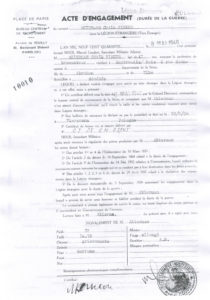
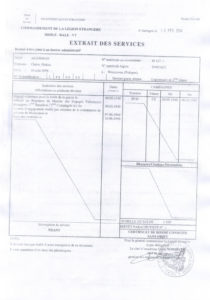
Jeanne (known as Nénette) Kerbel’s testimony – January 2019
“In 1941, at the age of fourteen years and a day, I went to work at the Dantzer factory in Montreuil. I had an operation for appendicitis. My friends came to see me in the hospital and brought me pastries bought on the black market.
Adèle (known as Dédelé) Schaffier’s testimony – November 2016
“In the spring of 1941, at which time there were constant rumors about arrests of foreign Jews, my father took refuge in Castelsarrasin (in the home of a Mr Ballarin, a seed merchant). He was never worried, hoping to bring us there too someday.
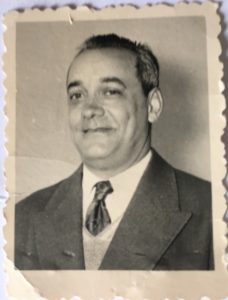
Date unknown: signed Monsieur Ballarin B.R.
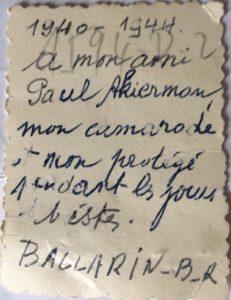
On the back is a dedication “to my friend Paul Akierman, my comrade and my protégé during the fateful days”.
(Paul was Chaim’s nickname).
Jeanne’s testimony
“In June 1942, we had to wear a yellow star.” This distressing measure was in addition to all of the other restrictions that applied to us: not to shop after 6pm, not to enter parks or public gardens, to be obliged to take the last metro, etc.
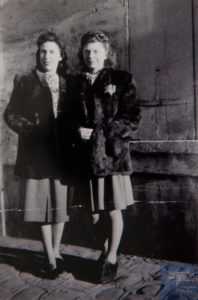
Photo at the beginning of this biography – date unknown (but after June 1942): Germaine and her friend Jeanne Kravetz – from Claude Schouflikir’s collection
Alain’s comment: Note that it was only Germaine who had to wear a star. Jeanne Kravetz did not, because the Kravetz family, never having registered with the Vichy administration, did not wear them and never had to worry about it.
Adèle’s testimony
“In June 1942, my mother was summoned to the Police Station to collect the yellow stars, which were given in exchange for ration coupons. The next day I went to the Jean-Jaurès school feeling very ashamed. In the courtyard, along with other Jewish girls, I was subjected to jeering from other pupils. The principal, Madame Perrin, called in all the classes and threatened the pupils with immediate exclusion if such events were to happen again. There were never any more such outbursts.”
Having established that Chaïm had been reported as “missing”, Germaine, a French citizen, was declared the “breadwinner”, thanks to the involvement of a social worker who had been sent by her employer, Mrs Dantzer. Germaine then received money from the Vichy regime’s Family Allowances department.
In July 1942 (the 16th or 17th?) two uniformed officers came to tell us to pack our bags. They came back in the afternoon and took us to the Marcelin-Berthelot school.
On the way, passers-by gave us tokens of their sympathy (such as a piece of bread) and sad looks.
At school, there was a Police Commissioner, in charge of meeting the Jews to inform them of their arrest.
At first glance, he seemed to us particularly tired and overwhelmed.
Having asked my mother, who did not speak very good French, he did not understand why we were named after our father when my mother was listed as Rosenberg. My older sister Germaine explained to him that our parents had been married in Poland in a religious rather than a civil union.
Faced with this state of affairs, which seemed incomprehensible to him, with Germaine insisting on trying to explain the situation, the policeman sent us home saying “Get the f… out of here”. We left to the applause of the onlookers. It appeared to us that we were the only ones to leave.
From July ’42 to February ’44, we led a “normal” life: my sisters were working and I was going to school “without any problems”.
Bernard‘s testimony
“At the beginning of July ’42 – I don’t remember the exact date – my mother’s sister, Gitla Finkelstein, came to live with us in Montreuil for a few days with her son Bernard. Bernard was my best friend and I loved playing with him. His father Maurice had stayed in Paris, on rue Charlot.
After a few days, Gitla and Bernard decided to return home. I insisted on accompanying them. My mother and my aunt thought it was not a good idea and despite my remonstrations, I stayed in Montreuil. A few days later, all three were arrested during the July 16 roundup.”
Jeanne’s (known as Nénette) testimony
As Adèle said, we went to Marcelin-Berthelot in July 1942, where, during Germaine’s explanation, the overwhelmed policeman gave us the order to f…. off out.
A comment from Alain
“Maurice Finkelstein was deported on July 31, 1942 in convoy 13, Gitla on August 3 in convoy 14 and Bernard on August 24 in convoy 23.
Also arrested during this round-up were:
– A cousin of my grandmother, Mala Czarny, deported on August 3 in convoy 14,
– His son Henri who would be deported on August 26 in convoy 24.
– Yankel, husband of Mala and father of Henri, had been arrested in May 1941 and was deported on June 22, 1942, in convoy 3.
– Their other two children, Rosa (nicknamed Rosette) and Jean, were in a sanatorium and ultimately escaped deportation.”
In early 1944, Aloïs Brunner’s hatred of the Jews forced Germaine to split up her family.
Jeanne (Nénette) continues:
On February 4, ’44, when the Germans knocked on our door, our neighbors told them that we were not there. The next day, I went to take refuge with my friends the Boyenval family, who lived on rue de la Noue in Haut-Montreuil. Thanks to a friend in the Resistance, I was to be placed with the Roussel family in Saint-Germain-en-Laye. Before going there, I accompanied my brother Bernard to Montparnasse station, since he was being sent to the countryside.
At the Place de la Nation, we were stopped by a young police officer, who asked us where we were going. I replied that my little brother was sick and that he was going to get some treatment in the country. That was all he needed; he let us through.
Adèle:
On February 4, ’44, the Germans arrived at our home and tried to get in. One of our neighbors informed them that we were not there, so they left.
The next morning, we left our home. Our neighbors on the ground floor (the Cretaz family) took us in. Germaine then took us to some friends, the Blumenthals (who had never been registered) and quickly separated us.
I stayed in various places, including Fontenay-sous-Bois, in a boarding house for young girls.
On the advice of Madame Perrin, I continued my schooling and passed an entrance exam for 6th grade. I was taken in by the UGIF (l’Union Générale des Israélites de France) in Montreuil, along with my brother Bernard, but we did not stay there very long because the management feared for our safety. My sister Jeanne settled in Saint-Germain-en-Laye. My brother Bernard stayed with farmers in the Sarthe region.
Germaine:
“I managed to contact, through a priest, the Congregation of Our Lady of Sion led by Father Théomir de Vaux so that Bernard could be entrusted to a family in the countryside.”
Bernard:
“In February 1944, with Germaine, I met Father Théomir de Vaux. I was very impressed by this bearded giant.
An appointment was scheduled in Montparnasse:
My sister Jeanne accompanied me to the station (we had removed our stars) to Nation, where we had to change. A young policeman stopped us and asked us where we were going. Jeanne replied that I was sick and that I was going to the countryside, so he let us through.
In Montparnasse, Vaux’s father was waiting for us with two young girls, who were to accompany us, and four Jewish boys.
When we arrived at Ecommoy train station, I was greeted by a farmer (Mr Auguste Landeau), who took me first to a certain Mr Muller and then to the Gendron family.”
Alain’s comment: The Gendrons would be honored with the title of “Righteous Among the Nations” in 2003. For more about the Gendron and Landeau families: see the AJPN.NET website.
File in the name of Bernard Akiermann, alias Acker, (Jean Laloum of the CNRS-GSRL, microfilm archives of the CDJC entitled ‘Registre des Sœurs de Sion’ – see footnote).
Chronological list of fees paid to the Gendron family from February to November 1944.
Germaine:
“My sister Clara also gave money to help cover his needs”
See document 2, in the left margin: “Respondent Mme. Bouri (Clara)”.
Germaine:
“I did what was necessary to ensure that the rest of my family was far away from Paris.”
Dated May 3, 1944 :
Germaine, her mother Syma Taubé, her little brother Roger and her friend Paulette Dzialochinski.
On the back : “To my dear little brother, a reminder of a separation that will be brief, I hope.”
Testimony of Robert Wacjman, Germaine’s cousin:
“We lived in Lyon, and I was arrested with my parents on May 24, 1944. We were locked up in the Montluc prison where my father Maurice was shot on June 3. Jeannette, my mother and I were deported in convoy 76, after which we survived, despite, in my case, several transfers from camp.”
Adèle:
Germaine stayed in Montreuil, at the Dantzer factory, to provide for our needs.
On the advice of a social worker, we (my mother, my little brother and I) were part of a group of refugees from the Vaugirard area, bombed by the Allied Air Force, who were evacuated to the Jura region, near Poligny.
My mother being a Polish-speaker, I told the authorities that we lived on rue Lecourbe in Paris and that we wanted to escape the bombing.
In July 1944, Germaine, left alone in Montreuil, was denounced and deported to Auschwitz. Back in Montreuil, in November 1944, I found my family again. In search of a home (never having regained ours) we waited for the end of the war, in anguish, for Germaine’s return in June 1945.
Germaine:
At the beginning of July 1944, alone in Montreuil, while still staying at the Dantzer’s house, on my way back from work I met a patrol of police officers who were taking a Jewish family from Montreuil to the police station. The head of the family pointed to me and asked the police officers to release them (him and his family) and to take me in exchange. On the way, as a captive, I met my friend Ginette Renard, I asked her to contact my sister Clara so that she could send some money to Bernard.
I was driven to the police station and then sent to the Detention Center at the Police Headquarters on 5 July. I was interrogated by the Authorities to find out if there were any other family members so that they too could be arrested. Afraid for them, I refused to say anything.
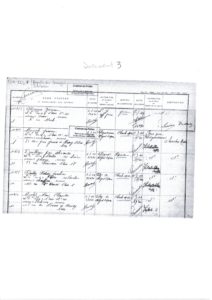
Source: Archives of the Préfecture de Police de Paris- Registre des consignés provisoires (Registry of provisional records) CC2/8:
Reason “Jewish”
Destination: Drancy.
Source: National Archives – Family File-F/9/5605
This sheet 83 mentions my Jewish file number (61712) and contains several errors: born on 17 09 1925 and that “I” was a stenographer!
In the middle of the page, a note: Interned Drancy, date 05 07.
Miscellaneous information: SS AJ AO.
SS:?
AJ: Jewish Affairs.
AO: This would mean handed over to the German authorities.
At the bottom of the page: stamped food ration card.
Source: Shoah Memorial. J 61712, Akerman (sic!)
The same erroneous information.
“I” am searched and “I” give in my watch (slip 6265)
Original document entitled “Camp de Drancy” dated 05 07 1944.
Source: CDJC (Center for Contemporary Jewish Documentation) Archives – Shoah Memorial.
Transcription from the original stubs of the logbook 154 dated 05 07 1944.
Source : CDJC (Center for Contemporary Jewish Documentation). In Drancy, “I” met the Drai family and I made friends with their daughter Perlette and another young girl, Mathilde Jaffe.
Departure Form dated July 31, 1944.
Source: National Archives – Adult Drancy File-F/9/5675 : This form is dated 31 07 1944
The same information but a different address: 35 rue François Arago.
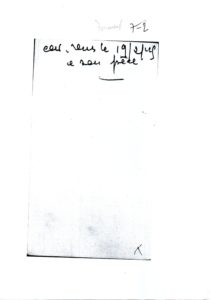
On the reverse side of 7.1, Document 7-2:
Note “c (illegible word) handed over to his father on 19 02 1945”.
35 rue François Arago: the place where the Akiermans lived when they returned to Montreuil in November 1944, Paris having been liberated, the Akiermans not having regained their accommodation on rue Hoche.
Form n° 34 104: Confirmation of presentation of identity card
Archive of unknown origin: Akerman (sic!) (References at the bottom of the document: MK 490.105 f-506)
Bernard: “In July, I received a letter telling me that Ginette would take care of me from now on; I understood that something had happened to Germaine”.
Germaine:
I left with convoy 77 on July 31 with numerous other children arrested in UGIF homes.
We arrived in Auschwitz-Birkenau at the beginning of August. The selection was carried out by Mengele. Perlette’s parents were sent to their final destiny.
Along with Perlette and Mathilde, I was allowed to enter the camp. We were trying to find out where Perlette’s parents and the children who were part of our convoy were.
The other deportees, who had arrived some time before us, pointed to the sky. We refused to believe it. Unfortunately, the truth came to us very quickly. Living conditions were harsh: shared beds, shared latrines etc.
We spent our time moving stones from one place to another for no reason other than to exhaust ourselves.
Every morning, at dawn, the shouts outside seemed to last an eternity.
In November 1944, I was sent to the Kratzau camp in the Sudetenland.
“I worked in a weapons factory that I would like to have seen bombed by the Allies. We wanted to end it all and to die beneath the Allied bombs.”
A little later, around April 1945, I was “lucky” enough to work in the kitchens (where I met Mengele for the second time). I looked at him, he asked me to look down and stop staring at him. I finally give in.
On May 8, 1945, Germaine was liberated by the Red Army, who entered by the gates of the camp:
“You are free women”, an officer, thought to be Soviet, told us in French.
We joined a group of recently released French prisoners of war.
On the way back to Paris by train, I first went to the Lutétia Hotel.
I remember a person at reception who refused to let me choose clothes “too luxurious”, in her opinion, for a poor suburban woman like me. I went back to Montreuil. Word had spread that I was coming back, so I was besieged at the Robespierre subway exit by a lot of people hoping for news of their families. They showed me pictures to see if I recognized them and asked in particular if they were still alive. I couldn’t tell them the truth: they would never see them again.
I found my family in Montreuil, and we lived at 35, rue François Arago because it was impossible for us to get our apartment back.
Jeanne:
“I came back every Sunday rue François Arago, in Montreuil, to do the cleaning at the shop where we lived, having been unable to get our home back”.
Germaine:
“I married Joseph Jablonski on May 8, 1947 and gave birth to two twins (Alain and Michel). Nelly followed in 1954”.
Document 9 : from the “Journal Officiel de la République”, 27 May 1942, with regard to appointing Temporary Administrators for the Companies “casually deprived of theirs” – The administrator Grapillard is appointed to manage the Akierman company.
This biography was researched and written by Alain, Michel and Nelly.
Translator’s footnote
- CNRS: Centre national de la recherche scientifique (National Center for Scientific Research).
- GRSL: Groupe Sociétés, Religions, Laïcité (Group on Societies, Religions and Secularism) – a research team in the humanities and social sciences.
- CDJC: Centre de Documentation juive contemporaine (Center for Contemporary Jewish Documentation).
- Registre des Soeurs de Sion (Registry of the Daughters of Zion) – the title of the microfilm archive in which the document is found.


 Français
Français Polski
Polski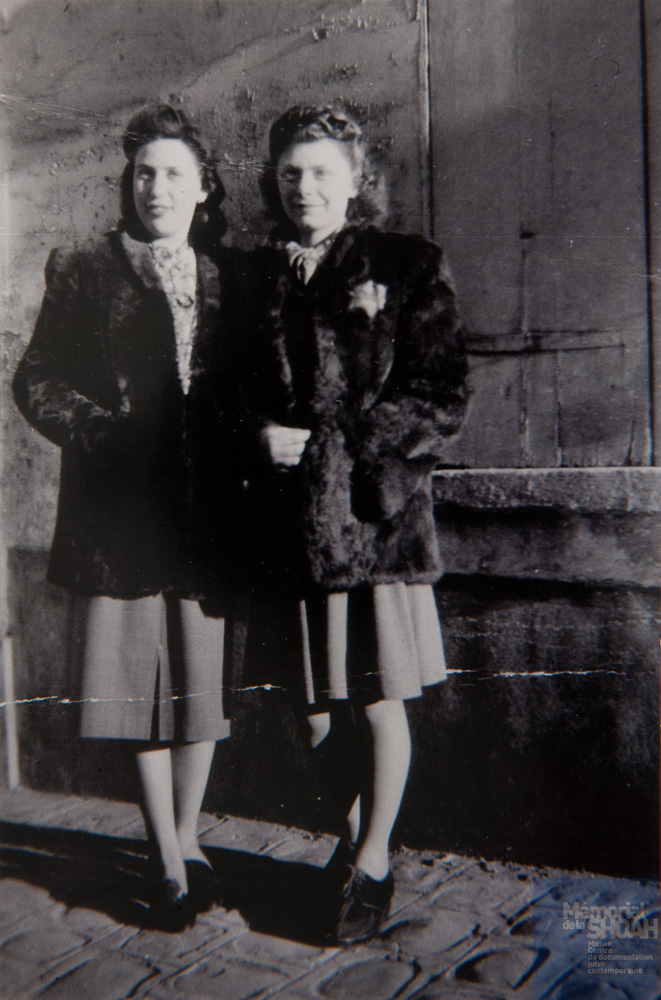
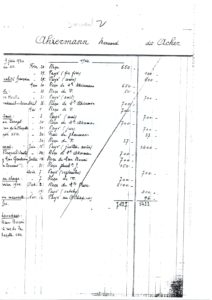
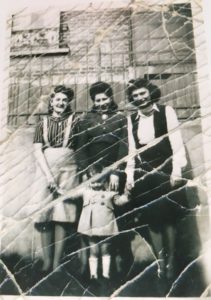

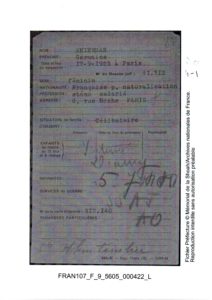
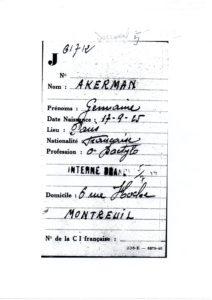
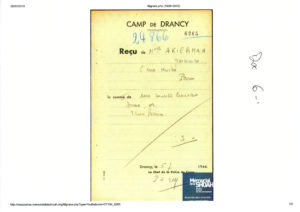


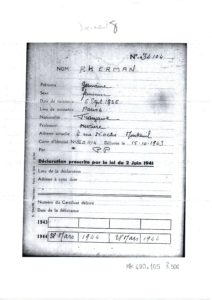










Comme il est important de connaître l’histoire d’une partie du passé familial….
C’est un devoir de mémoire pour les descendances à venir.
Roger Akierman
né en 1941, j’ai pris connaissance de certains faits en étant plus agé .
Maintenant, à 78 ans par le texte ci-dessus j’ai encore appris des choses que
j’ignorais sur ma famille durant ces années noires.
Ce qui m’a beaucoup ému c’est le verso de la photo 3 où ma sœur Germaine
décédé en 2016 écrit sur notre prochaine séparation. Il faut noter que l’écriture
de ma sœur jusqu’à quelques années avant son décès est restée la même.